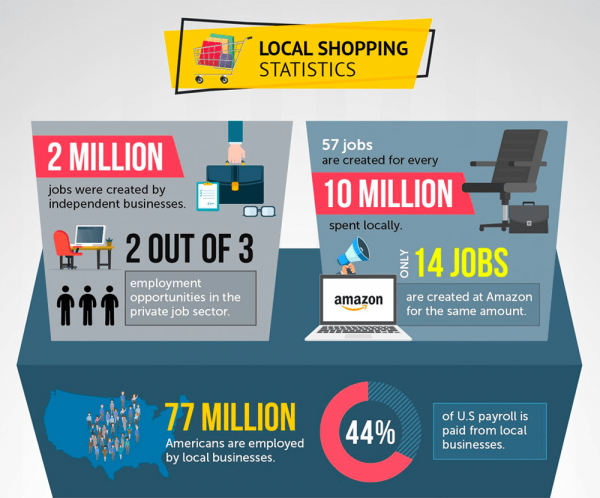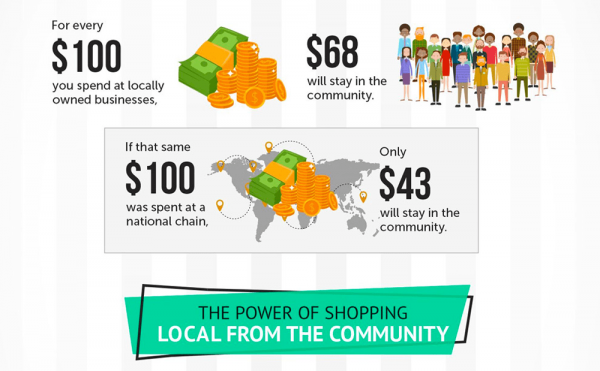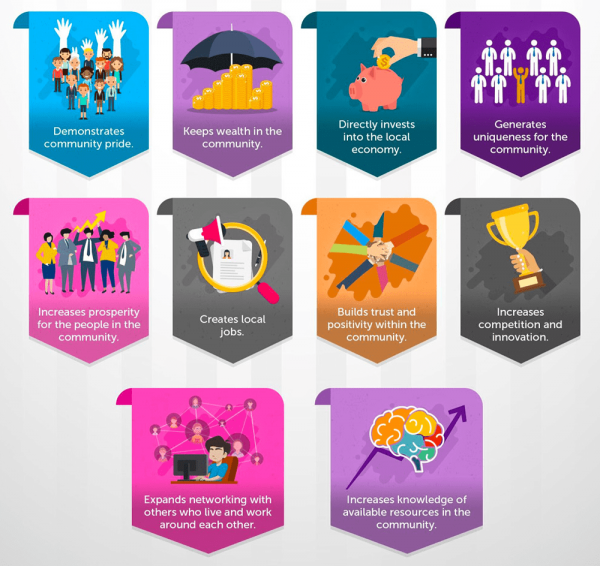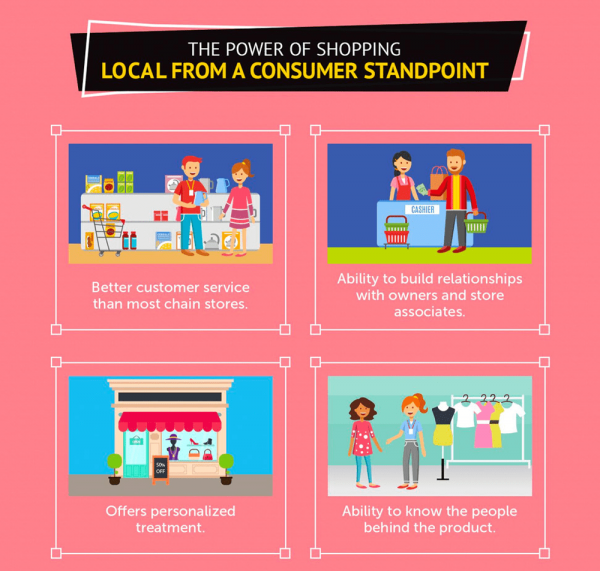20 Things Small Business Owners Need to Know
By Rieva Lesonsky
1—The Truth About Shark Tank
Are you a fan of Shark Tank? Here’s some scoop from Digital Exits about what works when pitching the sharks. For instance, did you know 85% of successful pitches are primarily product based? Check out the infographic below for more information.

2—Small Business Outlook 2019
Visa has just released its Small Business Outlook for winter 2019. Visa says the Small Business Outlook shows “robust economic growth continues to drive expansion among small business owners.” The Small Business Outlook shows 45% of small businesses says the economy improved last quarter—and experienced increased revenues. See the slide below for details.
Other highlights of the Small Business Outlook included:
- Only 31% of small businesses intend to increase their spending in the next three months
- 79% of small businesses pay off their credit card balance every month
Of the 21% of businesses that don’t pay off their balance
- 43% have scaled back
- 37% have experienced a decrease in revenues

3—The Power of Shopping Local
Local shopping can have a significant impact not only on customers but an entire community as well. Local businesses create local jobs, establish trusting relationships, increase competition and spread knowledge of locally-available resources. Consumers should strive to shop locally to help their communities. Look at the infographic below from Pink Coconut Boutique to see how the power of shopping local is changing communities around the nation for the better.






4—Social Media Fuels Business Growth
Hootsuite, a leader in social media management, in collaboration with We Are Social, the global socially-led creative agency, just released the 8th annual Digital 2019, which examines digital trends and social media use across 230 countries and territories. The report discovered more than one million new people go online every day, and 45% of the world—nearly 3.5 billion people annually—are logging on to their favorite social platforms. That’s a near 9% increase year-over-year despite growing concerns of fake news, fake followers and data privacy in 2018.
“Although social media came under increased scrutiny and saw diminished trust among users in 2018, people around the world are spending more time on social—the global daily average is now 2 hours and 16 minutes, or one seventh of their waking lives,” notes Penny Wilson, CMO of Hootsuite. “But to capture the attention of customers, brands need to rethink how they engage on social. Businesses must be respectful of their customers’ privacy, while still creating personal 1:1 connections via content that’s important, interesting and timely to the audience while being genuine and authentic to their brands.”
Delivering content for mobile consumption has become increasingly critical as the majority of active social users—3.25 billion—access social networks through their mobile devices. However, which social networks people use—and the way they’re engaging with them—is changing.
Facebook retains its position as the most popular social media network worldwide. Brands can now reach 2.121 billion people around the world with Facebook ads. And although growth is slowing, Facebook is still expanding its user base. In just the last quarter of 2018, Facebook grew 1.7%, or by 37 million monthly active users. Instagram has a smaller user base at approximately 1 billion active accounts, but it’s growing at a faster rate. Instagram grew 4.4% in the final 3 months of 2018, or by 38 million active users. The active advertising audience of Twitter and Snapchat declined by 2.7% and 12% respectively.
“Despite controversy around privacy, hacking, fake news and all the other negative aspects of online life, the world continues to embrace the internet and social media,” says Nathan McDonald, cofounder and Group CEO of We Are Social. “Brands need to develop creative, socially-led strategies to make the most of changing habits—especially when it comes to incorporating video and adapting to voice-controlled devices.”
When it comes to messaging apps and the rise of messaging among users, Facebook also continues to dominate. The company’s investment in WhatsApp maintained its place as the global favorite in 133 countries, while Facebook Messenger is number one in 75 countries, including the United States. WeChat remains the messaging app of choice for those in China.
Global internet and social media use is also propelling e-commerce. More than 2.8 billion people purchased consumer goods via e-commerce in the past year, up 3.1%. 75% of internet users have bought something online in the past month, the majority from mobile devices. Collectively, that led to $1.786 trillion in global online consumer goods spending, a jump of 14% year-over-year. More and more digital e-commerce is happening on social as users enjoy the convenience of purchasing direct from their social feeds.
5—Global Survey Reveals Strong U.S. Performance
More than 80 % of SMB commerce businesses reported maintaining or growing revenue in 2018 despite the challenges competing against global rivals. This, according to the inaugural State of Small Business Global Report by TradeGecko, a leading cloud-based commerce platform for growing companies, in collaboration with Golfdale Consulting.
SMBs are the lifeblood of the global economy, making up over 95% of all firms and 60-70% of total employment. “Small and medium businesses are punching above their weight when it comes to competing in the global market against large firms with big teams and big budgets. But as they grow, they are being stretched by operational issues and manual processes. Cloud-based services, social media and digital channels are levelling the playing field in all areas of running a business—marketing, accounting, sales, payroll, and inventory and order management,’ says Cameron Priest, cofounder and CEO of TradeGecko.
The survey shows agile small businesses are highly digitally savvy; leveraging social media and technology to level the playing field with bigger competitors when it comes to marketing their products. Businesses with less than $1 million in revenue relied primarily on word of mouth to generate buzz about their products with Facebook (74%) and Instagram (43%) being the dominant social media platforms.
As SMBs grow, they rely on a broader channel mix including bricks-and-mortar, in-person sales, wholesalers and distributors. This is reflected in their social media strategies, with firms earning more than $5 million in revenues using channels such as Twitter (37%), YouTube (37%) and LinkedIn (36%) for promotion campaigns.
Almost a quarter of SMBs with less than $1 million in revenue still rely on pen and paper for their inventory management, with another 31% using spreadsheets. These businesses spend, on average, over 90 hours a month on critical backend functions such as order and inventory management as well as product sourcing. Even larger businesses (over $5 million in revenues) rely on manual processes, with more than half reporting using spreadsheets. Many respondents report having too much, or not enough stock, with 70% regularly experiencing ‘overstocking’ or ‘stocking out’.
In general, the study shows that while tough competition (31%) remains the biggest challenge for founders across the board, the day-to-day pressures of running a business have an impact. Insufficient time (27%), hiring the right staff (26 %) and operational issues (21%) were among the biggest factors cited by founders as holding their businesses back from growing more quickly. Owners would like to spend more time on marketing, sales and product development.
“Being a business founder often means being a ‘Jack and Jill of all trades’ but as your business succeeds you can leverage technology not just to sell product but to build scalable operational systems that will support future growth,” adds Priest. “Flexible online tools give SMBs the superpowers they need to compete with larger rivals and ultimately free up business owners to do what they do best, build amazing businesses.”
6—The Simple Way Your SMB Can Improve its Margins
Guest post by Robert Maynard, founder, SurchX
Over the 2018 holiday season, nearly 30% of Americans applied for a store credit card. Today, Americans are increasingly choosing plastic over cash, and while an increase in spending is good for sales, it can mean tighter margins for small businesses. For merchants taking on the rising costs of processing fees, the struggle to improve margins over time can feel like a losing battle. High-fee rewards credit cards, contactless payments, and cashless option are further complicating things—and aren’t expected to slow down anytime soon. Consumers expect they can use their payment of choice in-store or online—and aren’t afraid to take their business elsewhere if they can’t.
Rethinking payments: With an average of 3% taken for every purchase made, fees associated with credit card use have put small retailers in a difficult position—eating away at profits for the sake of service and sales. Yet, data from a recent SurchX survey shows small to mid-sized U.S. merchants are increasingly worried about big box retail competition, and tighter margins are forcing them to make up for these costs in other ways—whether it’s adjusting operational expenses, limiting inventory costs, or implementing smarter marketing tactics. While these strategies help, it’s often too little, too late.
As credit card processing fees climb higher, the ability for small and mid-sized businesses to control surcharges against their margins is getting out of hand. In fact, data shows, 91% of merchants agree that credit card processing fees have increased for their business in the last five years, and 70% say they are paying more than expected in fees. On top of that, the recent spike in rewards cards is not helping because they cost more to process.
Regaining control: There’s no good option to regain control of margins from processing fees. Many add nominal swipe fees for credit card purchases or enforce minimum purchase amounts. Payment processors, federal and state regulations are enforcing the byzantine regulations that merchants must adhere to in order to surcharge in a compliant manner.
However, processing fees no longer have to be a cost retailers are forced to bear. For far too long merchants have sacrificed their margins—profits that could keep them in business, and help them improve service, product quality, and attract talent. The reality is, credit card processing fees are an unrealized opportunity to quickly and securely improve margins while staying in compliance. By passing fees back to the customer at checkout, merchants can cut expenses in a big way, but they must stay in full compliance. For retailers worried about customer reaction, data shows consumers are willing to pay the processing fee. In fact, 98% of all consumers say they have or would pay a surcharge up to 5% without abandoning a purchase.
Credit cards and processing fees aren’t going away, but for retailers, they no longer have to be a business risk. Today’s shoppers are willing to take on these fees in order to keep buying from the businesses they know and love. This year, retailers have the opportunity to abate the pain of processing fees and improve margins, giving them more time, money and energy to focus on what matters most: customer experience.
7—4 Top Emerging Startup Industries for 2019
Influencer agencies, life coaches, artificial intelligence-driven healthcare and drone-related businesses are among the hottest emerging industries for startups in 2019, according to data released by global creative platform 99designs.
99designs identified the following four themes as the fastest-growing and strongest newcomers of 2019 based on an analysis of design projects completed on the site at the end of 2018 compared to the previous five years:
- Artificial Intelligence (AI) healthcare: Up 48% compared to 5 years ago, significant advances in AI technology along with the demand for access to convenient medical care are driving this sector’s growth.
- Personal coaching: Experiencing a steady 47% increase in the past five years, life coaching is an industry truly on the rise, covering everything from financial and career guidance to health, wellness and relationships. The idea of personal coaching has established itself as an effective and accepted tool for self-development, driven by increased methods of mobile and remote communication.
- Influencer agencies: Influencer agencies made five times as many requests for design work on 99designs last year than they did in 2013—a whopping increase of 320%—and there was a particularly sharp increase between 2016 and 2018 when its numbers grew 79%. This growth is a result of the continued rise of Instagram along with metrics proving the effectiveness of this channel for marketers, which in turn creates more demand for agencies connecting businesses with influencers.
- Drones & drone-related businesses: With just a few dozen design requests five years ago, the drone industry has seen 680% growth since 2013 and continues to skyrocket, driven by tech advancements making drones more accessible. As the technology moves into the mainstream, industry growth is supported by the expansion into related areas such as drone reporting and drone tech analysis.
“Looking at the types of companies getting logos and design work from year to year is a fun way to spot what’s hot and what looks to be dying down,” says 99designs COO Pamela Webber. “While last year saw a notable boom in cryptocurrency, VR and cannabis—industries that are still requesting lots of creative work on the platform today—the obvious newcomers on the rise in 2019 involve bot doctors, Instagram celebrities and drone-adjacent services.”
There’s more information and illustrations at the 99designs website.
8—Cannabis Industry Growth
There’s no question the cannabis industry is growing—rapidly. Check out the infographic below from CaliExtractions and read their blog post on the Economics of Cannabis to learn more.

9—How Does an Omnichannel Vision Increase Sales Turnover?
Guest post by David le Douarin, co-founder & CEO, Advalo, a French predictive marketing platform. Advalo’s predictive marketing platform leverages artificial intelligence to detect intent-rich moments throughout the consumer journey. Advalo enables marketers to develop an individualized relationship with each customer, targeting key moments.
With the digitization of consumption patterns, being present on all channels is no longer enough to capture the attention of consumers. Multichannel strategy needs to be redesigned to benefit from an omnichannel strategy, which is essential today to support consumers throughout their purchasing journey. Which steps do the customer take before making their final purchase? How much time goes by before their first visit and final purchase? Did they only purchase online? These questions help improving customer journey knowledge and put an effective and coherent marketing strategy in place.
Digital: The gateway to stores: With the rise of e-commerce, many predicted the end of physical stores. These two retail spaces are largely complementary and are far from being in competition. Studies have shown consumers often prepare their purchase online before realizing it in a store. Today purchase decisions are made well upstream: 8 out of 10 in-store purchases are preceded by at least one online visit—an observation that can, and should, strongly influence the budgets allocated to digital directors. Looking at the numbers, a brand’s website turnover represents between 3-7% of global turnover. When digital is integrated in the shopping journey, it amounts to around 40% of the sales of the brand. To demonstrate this correlation, retailers need to reconcile “first party” data with navigation data, to better understand consumer behavior and purchasing patterns.
Get customers with omnichannel: Analysis of the omnichannel customer journey has two main objectives: increase the proportion of the budget allocated to digital tools and attract additional in-store customers through an individualized message on all points of contact. In this context, it is important to look at the conversion time between a website and in-store purchase. Brands that do not develop an omnichannel strategy do not have this knowledge and perform a relaunch at H1, which the customer can perceive as marketing pressure. By adapting the message to the time and purchasing journey of each consumer, the brand can individualize the relationship and customer experience.
In addition, each channel has its own specific features and added values for the consumer. Human contact in stores allows the customer to receive personalized advice, facilitating their act of purchase. Conversely, the ability to order products at any time of day and night is highly valuable for other consumers. The capacity to reconcile online and offline data from the same customer to adapt marketing strategy gives a real added value. The more the services offered are consistent with the channels in which they are offered, the more the strategy will pay off. We know, for example, that e-booking or click and collect often generate unanticipated additional item purchases. A customer does not think in terms of channel but goes where it is most convenient for them in the moment. It is therefore essential to know your client, thanks to a detailed analysis of their data, to offer a service that is consistent with their research and needs.
Omnichannel strategy is the real key to creating a seamless experience for the end consumer, without pressure or over-solicitation. A comprehensive view of their journey is necessary to deliver the right message at the right time. It is that focus that will make them want to finalize their purchase in one store rather than another.
10—New Marketing Advisor Program Launches
Constant Contact, an Endurance International Group company, just launched its Marketing Advisor program, consisting of a combination of dedicated personal and online resources. The company says the Marketing Advisor program is designed to provide small businesses with strategic and actionable guidance that will deliver results and is tailored to their unique goals. Developed in response to customer feedback and Endurance International Group market data that shows 84% of small businesses look for services that make marketing activities easier for them, the new program aims to help customers make sense of the quagmire of digital marketing.
“Small businesses are constantly bombarded by advertising telling them that digital marketing is quick and easy, but that’s just not the reality. They have to juggle everything from marketing automation to social media to email and e-commerce marketing. It creates a real burden. We realized our customers need advice developing strategies and building campaigns,” says Kim Simone, Constant Contact’s chief transformation officer. “Even small business owners who have a good strategy and get a taste for success need guidance reaching the next level. The Marketing Advisor program offers the one-to-one helpline they need to generate results and make better use of their time.”
According to an Endurance International Group study, 64% of the market feels overwhelmed when managing marketing and 76% like to have a detailed plan of action before beginning a marketing activity. And while they have ample ideas and access to tools for marketing, they often don’t understand how to make their marketing efforts work cohesively and end up using online marketing tools in a piecemeal fashion. They need consistent help in building an actionable plan that ties all their marketing tools and channels together.
Based on these insights, the Marketing Advisor program now offers one-on-one access to in-house experts, with experience in small business and nonprofit marketing, who are ready to provide strategic guidance and actionable know-how. The program uses an established marketing methodology to help small business owners build a personalized strategy they can execute to reach their goals. It also provides access to a community of fellow small business owners who can provide further insights and inspiration. Constant Contact’s Marketing Advisor program includes:
- A 30-minute phone call each month with a dedicated in-house marketing expert
- A customized, actionable plan based on customer’s needs and goals
- Access to a series of online resources including webinars
- Strategic direction on next steps to take
- Guidance for optimization activities, including list management and growth, email design, automated welcome series and reporting reviews
- Exclusive access to curated content
- Access to a private community board and moderated group chats
- An exclusive customer support phone number that puts the customer’s call into a priority queue so they get help fast.
11—Small Business Confidence
Small business owners are feeling good about the economy, according to the latest quarterly poll from CNBC and SurveyMonkey.
Key findings:
- 53% of small business owners think a recession in 2019 is “very” or “somewhat likely.” Female small business owners (61%) are more likely than their male counterparts (49%) to think a recession is on the way. Recession fears also break down along party lines. Just 38% of Republican small business owners say a recession is likely, vs. 79% of Democrats and 59% of independents.
- Overall, small business owner confidence is positive—52% of respondents say current business conditions are “good”, slightly down from 55% in Q4 2018, but up from 47% in Q1 2018.
- 20% say a government shutdown is a “major concern” for their businesses, 29% say it is a “minor concern.” And 50% are not concerned at all.
- 37% report being impacted by the recent government shutdown: 35% of those saw a slowdown in sales. 13% lost revenue from a contract with a government agency and 10% lost access to SBA loans.
“Though more than one in three small business owners were affected by the recent, record-long government shutdown, its impact barely registers in our overall measure of small business confidence,” says Jon Cohen, chief research officer at SurveyMonkey. “Key indicators of revenue growth, hiring expectations, and job openings reflect stability rather than volatility at the start of 2019.” You can read more from Cohen on SurveyMonkey here. And there’s more info on CNBC.
12—The Coffee Culture
The cup of coffee is constantly evolving, and with each different iteration it holds up a mirror to society, its standards, and innovations. RaveReviews fill us in on the history: Documented in 15th century Yemen, the first recorded events of drinking coffee were just the beginning of a globally-minded, yet locally-influenced, coffee culture. The role of the coffee house in our daily lives has evolved, and today some of the biggest business meetings take place in the humble coffee shop.
The cup of Joe aside, coffeehouses themselves are a cultural phenomenon, serving as a public yet intimate “third place.” Ray Oldenburg, sociologist, described the idea of the “third place” as an important cultural social setting outside of the workplace or home, like a bar or park or barbershop. This phenomenon and cultural demand for a neutral “third place” is present even in pop culture; episodes of beloved sitcom “Cheers” most often used their local bar as the setting. Eventually though, during the 1990’s, coffeehouses began to replace the local bar as the hangout spot, clearly visualized in sitcoms like “Seinfeld” and “Friends.” To most of us these days, the coffee shop is seen as the “third office” too.
The essence of the “third place” however is not limited to entertainment – some of the most powerful innovations and business ventures began in such a place. The New York Stock Exchange was the brainchild of a group of businessmen within the walls of the Tontine Coffee House in 1792. Across the country and nearly a century later, the Sazerac Coffee House of New Orleans saw the very first American cocktail named after itself for playing host to some of the area’s greatest thinkers and entrepreneurs of the time. Today the coffee shop is a popular place to hold meetings – a halfway point between two offices or a place away from the office.
Roasting, drinking, and flavoring trends come and go, but the enduring cup of coffee remains just as iconic as ever. No matter how you take it, coffee exudes it’s own culture – we’re just along for the ride. Take a look at this infographic from RaveReviews for more detail on the influence of coffee culture, from where it all began, and where we can expect it to bring us in the future.

13—AI in Business: 2019 Trends and Predictions
Guest post by John Williams, Head of Marketing, Instant Offices
AI is already being implemented in businesses around the world, and while worries persist over whether robots will be taking over the workplace, some are predicting that it will actually improve and even create jobs in the future.
From devices in our homes to mobile apps, AI has already made its way into our daily lives. The workplace is no exception and AI has already helped businesses make better use of data and streamline processes. Here are a few AI trends you should be aware of for your business:
AI on big data: Businesses are starting to use data to make decisions with the help of algorithms and real-time methods. AI assists with this by breaking down excessive data to help businesses make use of it. AI also uses machine learning and deep learning to improve predictive analytics, allowing businesses to offer customers exactly what they are looking for.
Voice assistants: Some of the most common AI technologies used in our daily lives are Alexa and Siri. Similarly, digital assistants using voice commands will soon make their way into the office. Businesses will benefit from this as it will improve employees’ understanding of applications and data and how to best use it.
Mobile apps: As data becomes a driving force in businesses, so will the mobile app development space transform to complement this growth. Mobile users are looking for a more customized experience, which companies want to give them in order to stay competitive. The role of the mobile app developer will, therefore, need to change as it will tie in closely with AI so that it can process data and learn from users
Automation via robotics: Robotics Process Automation makes use of AI to complete repetitive tasks at huge volumes, which can range from a simple business transaction to complicated processing and presenting of data. This system will save companies time and money as Robotic Process Automation is able to complete a task quicker and more accurately than an employee. In this way, businesses will save money.
A recent initiative from NPR shows what the approximate chances are that specific jobs will one day be automated. As part of the initiative, researchers looked at a wide range of jobs and scored them based on nine possible traits, including the social intelligence required to perform the job, being personally required to help others, and whether a job requires negotiation.
Could chat bots replace jobs? Facebook founder Mark Zuckerberg fueled a lot of hype around chat bots replacing human jobs after it was announced Messenger would be hosting more of them in the coming years. The aim is to help businesses build bots on the chat app so they can hold automated chats with people, which will eventually lead to more sales, bookings and brand awareness.
Bots are essentially cheaper and quicker to make than apps, with many industry experts saying that bots will take over from apps in the near future. Many of these bots are able to carry out tasks traditionally done by humans, including the following jobs:
- Customer service agents
- Fast-food servers
- Personal assistants
- Social media managers
While AI will definitely take over a few human jobs, it will also create new jobs. The role of computer scientist will be in high demand, while new roles will be created to run the AI, including engineers, accountants, and retail analysts. People will also be needed to prepare the data for the AI to process and to train employees on how to use this new technology.
The presence of AI will grow in the workplace, and while creating new jobs, organizations need to realize that the real challenge will be finding candidates to take over these new roles.
Check out their infographic for more information.
14—The Small Business Revolution—Main Street Names its Finalists
The public can vote at SmallBusinessRevolution.org for which small town will receive the revitalization and be featured in the reality show starring Amanda Brinkman, Ty Pennington and Deluxe experts
Deluxe Corporation named the finalists in its nationwide search for one small town to receive a $500,000 marketing and business transformation. You have until Tuesday, February 19th to vote for which town should win the makeover and be featured on Season 4 of Deluxe’s hit reality show Small Business Revolution—Main Street, which streams on Hulu, YouTube and SmallBusinessRevolution.org.
Deluxe received nearly 12,000 nominations for Season 4. Small business owners in the winning town will receive marketing support and business advice from a team of Deluxe small-business marketing experts, including chief brand and communications officer and host of the show, Amanda Brinkman. And for the second year TV personality and renovation icon Ty Pennington will serve as cohost of the popular series. Pennington will lend his expertise and will also support Deluxe in sharing the Small Business Revolution story.
The finalists for Season 4 are:
- Camas, Washington
- Canon City, Colorado
- Corsicana, Texas
- Durant, Oklahoma
- Searcy, Arkansas
- Washington, North Carolina
You have until February 19 to visit SmallBusinessRevolution.org and watch a brief video about each finalist town and then vote for your favorite. Once the winner is chosen, Brinkman, Pennington and the Deluxe Small Business Marketing Team will head to the winning town to provide marketing counsel and other assistance to selected business owners.
15—Do People Trust Apps that Share Their Location?
More than double the number of men (35%) are willing to share their location with dating apps compared to women (16%), according to a survey published by The Manifest, a business news and how-to website. Men are typically less cautious about sharing their data on apps while women are more concerned about the safety risks.
Businesses must consider consumers’ comfort levels and potential security risks when designing apps that collect data on location. Tracking users’ locations can benefit businesses, but some users will desire more privacy. This report found:
- 81% of smartphone users know how to adjust their phone’s location settings but may not realize their attempts to block location tracking are actually ineffective.
- Most users feel safe when using apps that track their locations—57% are comfortable with apps that track their location compared to only 15% of smartphone users who do not want apps knowing their whereabouts.
- 42% find location tracking apps convenient, while an additional 29% of people feel safer when apps know their location.
- 31% want complete privacy and don’t trust companies with their information.
You can check out more in this post at The Manifest.
16—Taking Advantage of Mobile Marketing
Smartphones have had an outsize impact on the way companies plan their marketing initiatives. There are more than one billion active smartphone users, and research shows people check their phones 80 times a day on average. This gives marketers an excellent opportunity for advertising.
But mobile marketing should take a multi-channel strategy approach, including a wide range of activities connecting advertisers to a broader customer base through mobile devices and networks. This works for marketers since it increases the value of the advertising that gets through.
When done right, this type of marketing provides customers with personalized information so they can get what they need exactly when they need it—even on the go.
Being early adopters of this marketing trend gave many renewed brands a tremendous advantage over their competitors. The team at App Geeks has created an infographic explaining how you can take advantage of mobile marketing.
Quick Takes
17—Want to be a better negotiator? Hiscox explains how.
18—If you’re looking to hire, you can check resumes quickly, thanks to the new partnership between Resume-Library and Zoho Recruit.
19—In the retail business? Check out the top 10 trends for retailers from RetailMeNot.
20—Want to rank higher on Amazon? Tom Buckland, founder of Amazon SEO Consultant, tells you how.
Business stock photo by Who is Danny/Shutterstock







